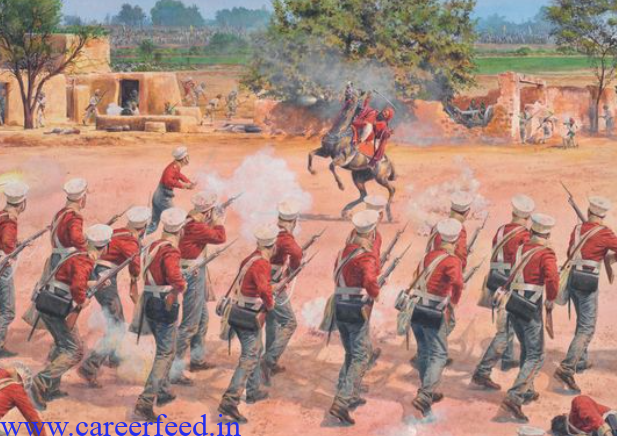Contents
hide
Third Anglo-Maratha War (1817 – 1818)- MCQ
- What was the chief reason for the Third Anglo-Maratha War in 1817?
a) Marathas’ desire to form an alliance with the British
b) British interference in Maratha internal matters
c) Marathas’ attempt to rebuild their old prestige
d) British conflict with the Pindaris - Who were the Maratha chiefs who forged a united front against the English in the Third Anglo-Maratha War?
a) Peshwa Bajirao II, Daulat Rao Shinde, and Malharrao Holkar
b) Mudhoji II Bhonsle, Daulat Rao Shinde, and Peshwa Bajirao II
c) Malharrao Holkar, Mudhoji II Bhonsle, and Peshwa Bajirao II
d) Daulat Rao Shinde, Mudhoji II Bhonsle, and Malharrao Holkar - Which Maratha chief was diplomatically pressured to stay away from the conflict in the Third Anglo-Maratha War?
a) Malharrao Holkar
b) Mudhoji II Bhonsle
c) Peshwa Bajirao II
d) Daulat Rao Shinde - What did the British suspect regarding the Pindaris in the context of the Third Anglo-Maratha War?
a) They were allies of the British
b) They were protected by the Marathas
c) They were a neutral force
d) They were fighting against the Marathas - How would you describe the British victory in the Third Anglo-Maratha War?
a) Prolonged and challenging
b) Swift and decisive
c) Costly and inconclusive
d) Diplomatic and strategic
Answers
- d) British conflict with the Pindaris
- c) Malharrao Holkar, Mudhoji II Bhonsle, and Peshwa Bajirao II
- d) Daulat Rao Shinde
- b) They were protected by the Marathas
- b) Swift and decisive
Third Anglo-Maratha War (1817 – 1818)- MCQ
- What territory did Shinde give up to the British as per the Treaty of Gwalior in 1817?
a) Punjab
b) Rajasthan
c) Gujarat
d) Bengal - What was the outcome of the Treaty of Mandasor signed in 1818 between the British and the Holkar chief?
a) British withdrawal from central India
b) Establishment of an independent Holkar state
c) Placing an infant on the throne under British guardianship
d) Surrender of Holkar’s territories to the Marathas - What happened to the Peshwa after surrendering in 1818?
a) Exiled to England
b) Dethroned and pensioned off to Bithur
c) Continued ruling as a British puppet
d) Became the Governor-General of British India - Who became one of the leaders of the Revolt of 1857 at Kanpur, succeeding the dethroned Peshwa?
a) Raja of Rajputana
b) Nana Saheb (adopted son of the Peshwa)
c) Holkar chief
d) Shinde - What did the territories annexed from the Pindaris become under British India?
a) Central Provinces
b) Punjab
c) Bengal Presidency
d) Bombay Presidency - What was the fate of the Maratha Empire after the Third Anglo-Maratha War?
a) Strengthened and expanded
b) Continued to resist British control
c) Ended and surrendered to the British
d) Formed a separate nation - Who was placed as the ceremonial head of the Maratha Confederacy at Satara after the war?
a) Peshwa
b) Holkar
c) Shinde
d) Descendant of Chhatrapati Shivaji
Answers
- b) Rajasthan
- c) Placing an infant on the throne under British guardianship
- b) Dethroned and pensioned off to Bithur
- b) Nana Saheb (adopted son of the Peshwa)
- a) Central Provinces
- c) Ended and surrendered to the British
- d) Descendant of Chhatrapati Shivaji
Third Anglo-Maratha War (1817 – 1818) – Study Notes
Background and Course
- After the second Anglo-Maratha war, the Marathas attempted to regain their lost prestige and reclaim their old possessions from the English.
- Discontent with British residents’ interference in their internal matters.
- The British conflict with the Pindaris (bandits) suspected to be protected by the Marathas became a chief reason for the war.
- Maratha chiefs, including Peshwa Bajirao II, Malharrao Holkar, and Mudhoji II Bhonsle, united against the English.
- Diplomatic pressure led Daulat Rao Shinde, the fourth major Maratha chief, to stay away.
- The British swiftly secured victory in the war.
Outcome of the war
- The Third Anglo-Maratha War marked the final attempt by the Marathas to regain their lost territories and prestige.
- The war resulted in the establishment of British dominance over the Maratha Confederacy.
- The defeat of the Marathas led to the formal dissolution of the Maratha Confederacy.
- Peshwa Bajirao II was dethroned, and the East India Company took control of his territories, marking the end of Maratha power in India.
Results of the Third Anglo-Maratha War (1817 – 1818)
- Treaty of Gwalior (1817 – Shinde)
- Signed between Shinde and the British.
- Shinde gave up Rajasthan to the British.
- Rajas of Rajputana remained as Princely States under British sovereignty until 1947.
- Treaty of Mandasor (1818 – Holkar)
- Signed between the British and the Holkar chief.
- An infant was placed on the throne under British guardianship.
- Peshwa’s Surrender (1818 – Bajirao II)
- Peshwa surrendered in 1818, was dethroned, and pensioned off to a small estate in Bithur (near Kanpur).
- Most parts of his territory became part of the Bombay Presidency.
- His adopted son, Nana Saheb, later became a leader of the Revolt of 1857 at Kanpur.
- Annexation of Pindari Territories
- Territories annexed from the Pindaris became the Central Provinces under British India.
- End of the Maratha Empire
- The war led to the end of the Maratha Empire.
- Maratha powers surrendered to the British.
- Ceremonial Head at Satara
- An obscure descendant of Chhatrapati Shivaji was placed as the ceremonial head of the Maratha Confederacy at Satara.
- British Control over India
- One of the last major wars fought and won by the British.
- With this, the British controlled most parts of India, barring Punjab and Sindh, directly or indirectly.
Reasons for Maratha Loss
- Lack of Unity: Among the Maratha chiefs themselves.
- Poor Relations: With other Indian princes and ruling dynasties.
- Failure to Understand British Strengths: Lack of understanding of British political and diplomatic strengths contributed to the defeat.





